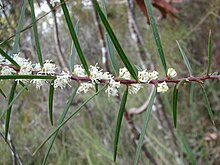Hakea ulicina, commonly known as furze hakea,[3] is a shrub in the family Proteaceae and endemic to Victoria. It has stiff, long, narrow leaves and creamy-white flowers.
| Furze hakea | |
|---|---|

| |
| Hakea ulicina in Bunyip State Park, Victoria | |
| Scientific classification | |
| Kingdom: | Plantae |
| Clade: | Tracheophytes |
| Clade: | Angiosperms |
| Clade: | Eudicots |
| Order: | Proteales |
| Family: | Proteaceae |
| Genus: | Hakea |
| Species: | H. ulicina
|
| Binomial name | |
| Hakea ulicina | |
Description
editHakea ulicina is an erect shrub or small tree growing between 2–5 m (7–20 ft) tall, resprouting from a lignotuber . The leaves are mostly linear, curving, rigid, 3–18 cm (1–7 in) long and 1–4 mm (0.04–0.2 in) wide with 1-3 prominent longitudinal veins on the upper and lower surface. The white flowers are borne in clusters of 6-18 in leaf axils, and the pistil 4–6 mm (0.16–0.24 in) long. Flowering occurs from late winter to spring and the fruit are ovate or obliquely ovate 1.6–2.5 cm (0.6–1 in) long by 8–11 cm (3–4 in) wide with a short, straight, pointed beak.[4][5]
Taxonomy and naming
editHakea ulicina was first formally described by Robert Brown in Supplementum primum prodromi florae Novae Hollandiae in 1830, based on plant material collected by William Baxter in Wilsons Promontory.[6][7] The specific epithet (ulicina) means Ulex-like.[8]
Distribution and habitat
editFurze hakea occurs on the southern slopes of the Great Dividing Range as well as in coastal heathland. It is mostly found from the east of Port Phillip Bay in Victoria through to Eden in south-eastern New South Wales. Additional populations occur in the Brisbane Ranges and Anglesea to the west of Port Phillip Bay, as well as Tasmania's Furneaux Group of islands.[9] A similar species from South Australia and western Victoria, Hakea repullulans, can be distinguished by its broader leaves and presence of a lignotuber.[10]
Conservation status
editHakea ulicina is listed as "vulnerable" under the Tasmanian Government Threatened Species Protection Act 1995.[11]
References
edit- ^ Haegi, L.; Keith, D.; Kirkpatrick, J. (2020). "Hakea ulicina". IUCN Red List of Threatened Species. 2020: e.T118138399A122768906. doi:10.2305/IUCN.UK.2020-2.RLTS.T118138399A122768906.en. Retrieved 13 March 2023.
- ^ "Hakea ulicina". Australian Plant Census. Retrieved 24 October 2021.
- ^ "Hakea ulicina". Local Plant Directory. Yarra Ranges Council. Retrieved 24 October 2021.
- ^ R.M. Barker. "New South Wales Flora Online: Hakea ulicina". Royal Botanic Gardens & Domain Trust, Sydney, Australia.
- ^ Corrick, M.G.; Fuhrer, B.A. (2001). Wildflowers of Victoria and adjoining areas. Australia: Bloomings Books. ISBN 1876473142.
- ^ "Hakea ulicina". Australian Plant Name Index (APNI), IBIS database. Centre for Plant Biodiversity Research, Australian Government, Canberra. Retrieved 2008-08-31.
- ^ Brown, Robert. "Hakea ulicina". Biodiversity Heritage Library. Retrieved 23 July 2019.
- ^ George, Alex; Sharr, Francis (2021). Western Australian Plant Names and Their Meanings (4th ed.). Kardinya, WA: Four Gables Press. p. 331. ISBN 9780958034180.
- ^ Stajsic, Val. "Hakea ulicina". Royal Botanic Garden Victoria. Retrieved 29 November 2020.
- ^ Stajsic, Val. "Hakea repullulans". Royal Botanic Gardens Victoria. Retrieved 29 November 2020.
- ^ "Hakea ulicina". Government of Tasmania-Threatened Species Link. Retrieved 10 November 2018.
